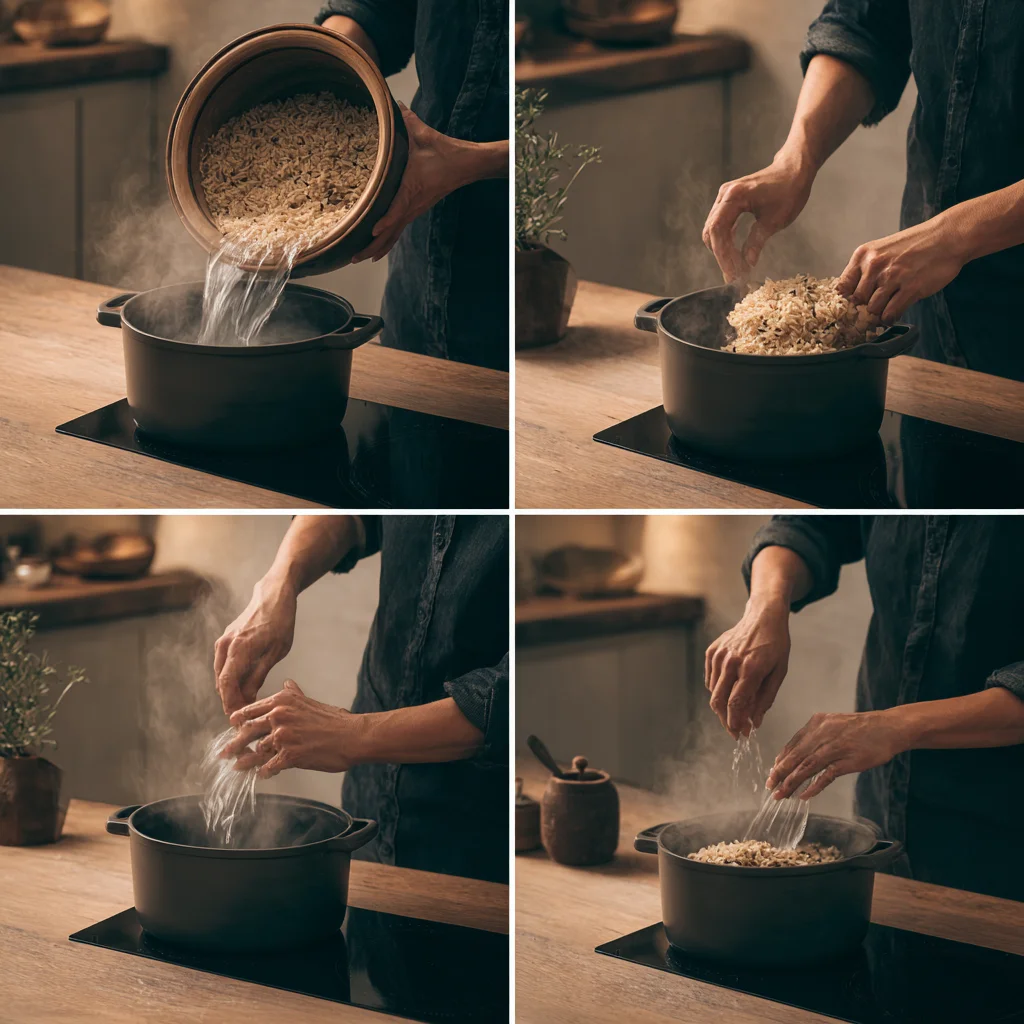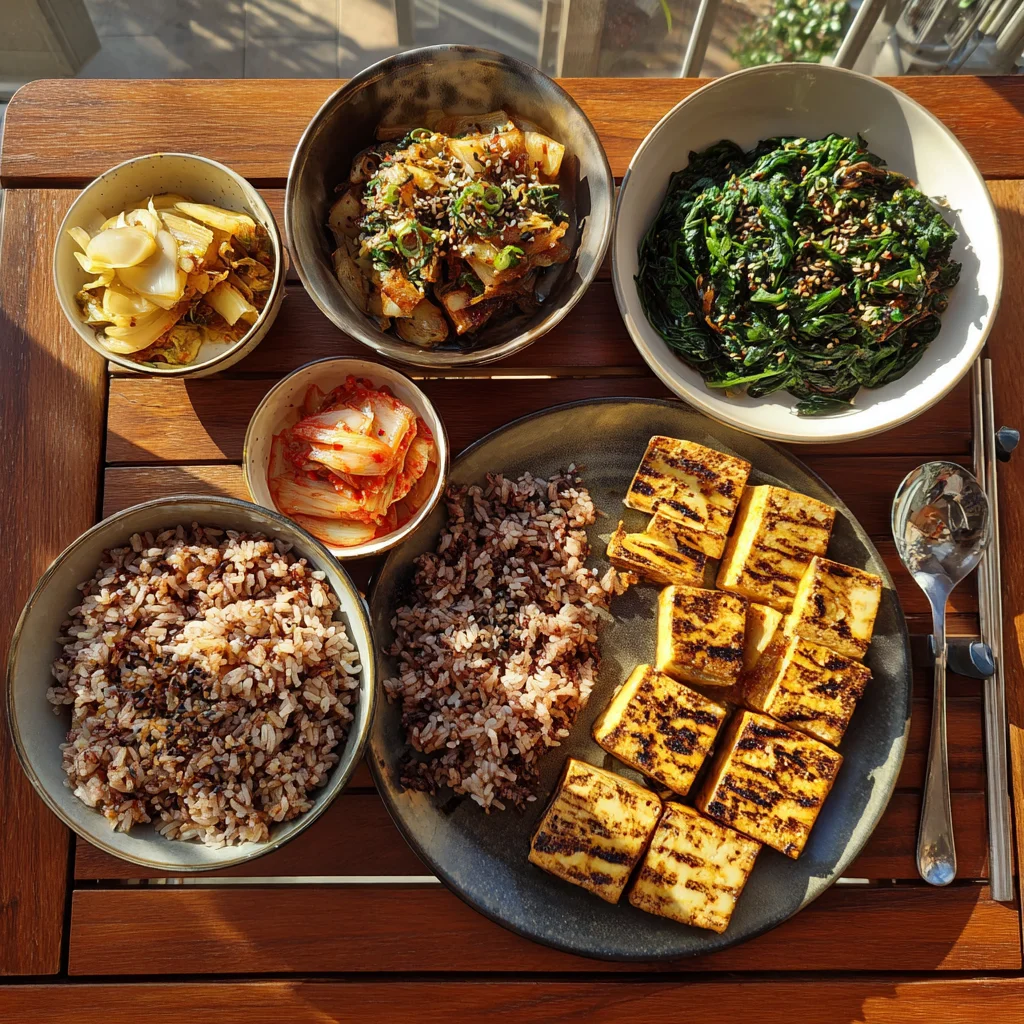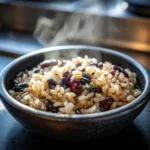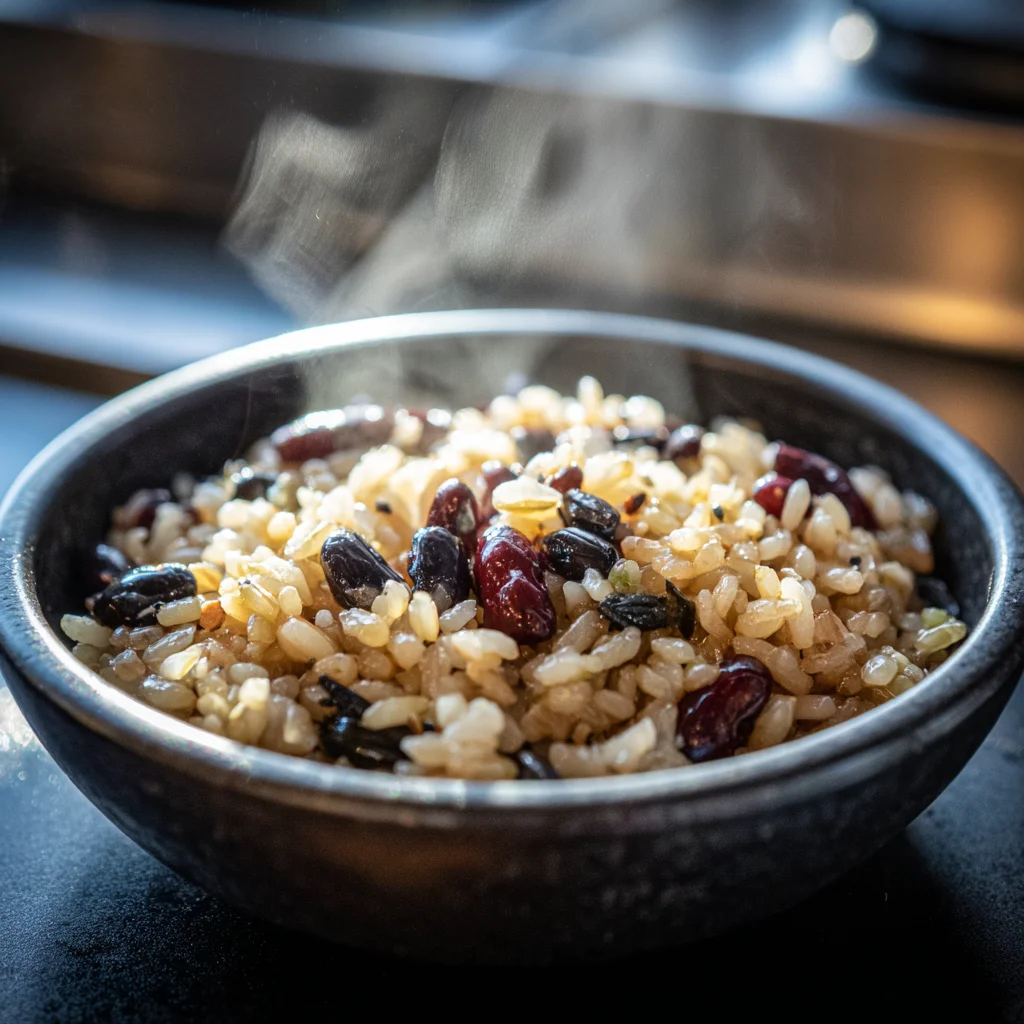Korean multigrain rice, known as Japgokbap in Korean, is more than just a colorful mix of grains—it’s a cultural staple packed with nutrition, flavor, and texture. As more health-conscious eaters shift away from white rice and explore nutrient-dense options, Korean multigrain rice is emerging as a popular choice. This article dives deep into the grains, benefits, and reasons why you should consider swapping your plain rice for this powerful blend.
Whether you’re curious about the taste, health advantages, or how to cook it properly, you’ll find everything you need right here. You’ll also learn why Koreans eat it daily and how it fits into their holistic food philosophy.
Discover great ideas like Detox & Metabolism Boosters to pair your rice with cleansing meal options.
Table of Contents
Table of Contents
Introduction to Korean Multigrain Rice
What is Korean Multigrain Rice?
Korean multigrain rice—often called Japgokbap—is a combination of short-grain white rice mixed with several whole grains and legumes. While the base is typically white rice, the added grains often include:
- Barley (bori)
- Black rice
- Brown rice
- Sorghum
- Millet
- Red beans (pat)
- Soybeans
- Oats
The specific mix can vary by household, restaurant, or region, but the goal remains the same: maximize nutrition and fiber while adding variety to a traditional Korean meal.
Common Grains Used in Korean Multigrain Rice (Japgokbap)
Here’s a breakdown of the most common grains used and their individual benefits:
| Grain | Korean Name | Health Benefits |
|---|---|---|
| Barley | 보리 (bori) | Lowers cholesterol, improves digestion |
| Brown Rice | 현미 (hyeonmi) | High in fiber, lowers risk of heart disease |
| Black Rice | 흑미 (heukmi) | Rich in antioxidants, supports brain health |
| Millet | 조 (jo) | Gluten-free, high in B vitamins |
| Sorghum | 수수 (susu) | Protein-rich, reduces inflammation |
| Red Beans | 팥 (pat) | Boosts kidney function, iron-rich |
| Soybeans | 콩 (kong) | Plant-based protein, balances hormones |
| Oats | 귀리 (gwiri) | Aids in cholesterol control |
Multigrain rice isn’t just about adding variety—it’s about elevating the health profile of a basic staple. Korean households often prepare a large batch of their favorite grain mix and store it in the freezer, ready to cook with fresh rice anytime.
Many Koreans consider multigrain rice not just healthier but also more satisfying, thanks to the chewy texture and deeper flavor compared to plain white rice.
Nutritional Benefits of Korean Multigrain Rice
Key Nutrients Found in Multigrain Rice
When you eat Korean multigrain rice, you’re not just enjoying a bowl of food—you’re fueling your body with a dense nutritional powerhouse. Here’s what a typical serving contains:
| Nutrient | Benefit |
|---|---|
| Dietary Fiber | Promotes digestion, reduces constipation, and helps manage weight |
| B Vitamins (B1, B3, B6) | Support energy production and brain function |
| Magnesium | Important for muscle function and heart health |
| Iron | Helps carry oxygen in the blood and reduces fatigue |
| Antioxidants | Found in black rice and red beans; protect cells from damage |
| Complex Carbohydrates | Provide steady energy release without blood sugar spikes |
| Protein (from soybeans and legumes) | Aids muscle repair and growth |
Unlike plain white rice, which is stripped of many of its nutrients during processing, multigrain rice maintains the natural integrity of its ingredients. That’s why many people transitioning to healthier diets find Japgokbap a delicious and sustainable alternative.
How it Compares to White and Brown Rice
Let’s break down how Korean multigrain rice stacks up against white and brown rice:
| Feature | White Rice | Brown Rice | Korean Multigrain Rice |
|---|---|---|---|
| Fiber Content | Low | Medium | High |
| Glycemic Index | High | Medium | Low to Medium |
| Micronutrient Level | Low | Moderate | High |
| Flavor | Mild, Neutral | Slightly nutty | Rich, earthy, complex |
| Texture | Soft, sticky | Slightly chewy | Chewy and hearty |
Multigrain rice’s lower glycemic index means it doesn’t spike blood sugar levels as quickly, making it a smarter choice for people with diabetes or those managing insulin levels. Plus, the fiber content increases satiety—keeping you full longer and helping control calorie intake naturally.
Why Koreans Eat Multigrain Rice
Cultural and Historical Context
Koreans have long believed that food is medicine. This philosophy, deeply rooted in traditional Eastern medicine, prioritizes balance and nourishment in every meal. Japgokbap, or Korean multigrain rice, perfectly reflects this way of thinking. Historically, white rice was a luxury, often reserved for the wealthy, while common households relied on whole grains and legumes.
Over time, as white rice became more accessible, so did health issues linked to highly processed foods. In response, many Koreans returned to their roots, incorporating nutrient-dense grains back into their diets. Japgokbap became not just a nostalgic staple but a modern health trend. Today, even upscale restaurants and lunch spots across Seoul proudly serve multigrain rice as part of balanced meals.
This shift isn’t just about nostalgia—it’s a nationwide movement toward mindful eating.
Modern Health Trends in Korea
In contemporary Korea, health trends heavily emphasize gut health, weight control, and maintaining youthful energy levels. Influencers and health experts often feature Japgokbap on social media platforms such as Instagram and Naver blogs, commonly serving it alongside kimchi or light vegetable sides.
Korean hospitals and clinics also recommend multigrain rice for patients managing:
- Blood pressure
- Obesity
- High cholesterol
- Type 2 diabetes
Schools, work cafeterias, and even airline meals in Korea increasingly serve Japgokbap as the rice base due to its well-known benefits. The popularity is backed not just by tradition, but by science.
Don’t miss our Healthy Baking & Treats to complement your meals with guilt-free snacks.
Taste and Texture of Korean Multigrain Rice
What Does It Taste Like?
If you’re accustomed to plain white rice, Japgokbap introduces a much more dynamic taste. Each component brings its own character:
- Black rice adds a rich, slightly floral note with hints of depth.
- Red beans create a robust and mellow background.
- Millet and brown rice round things out with a grounding, nutty presence.
The overall flavor is balanced and warm, offering subtle complexities that build with every bite. Many describe it as comforting and wholesome—more than just a side, it’s an experience. Even the simplest meals feel heartier and more complete when built around this grain blend.
How Texture Differs from White Rice
What sets Korean multigrain rice apart most is the texture. Instead of being soft or sticky like white rice, Japgokbap has a firmer, more satisfying bite. You’ll notice a chewy consistency that encourages slower eating and mindful chewing—important for both digestion and satiety.
Since the outer layers of the grains stay intact while cooking, they add a chewy texture and increase the fiber content. No two bites are the same—some grains are tender, others a bit springy—which keeps the experience interesting and far from monotonous.
Let’s compare the textures more clearly:
| Rice Type | Texture | Mouthfeel |
|---|---|---|
| White Rice | Soft, sticky | Smooth, minimal bite |
| Brown Rice | Lightly chewy | Uniform texture with slight bite |
| Multigrain Rice | Firm, hearty | Layered, with varied textures |
Thanks to this texture diversity, even basic rice dishes gain a gourmet feel, making you savor your meals more slowly and enjoyably.
How to Cook Korean Multigrain Rice at Home
Step-by-Step Instructions
Making Korean multigrain rice (Japgokbap) at home might seem intimidating, but it’s surprisingly easy once you get the hang of it. Here’s how to prepare it the traditional way, either in a rice cooker or on the stove.
Ingredients:
- 1 cup short-grain white rice
- ½ cup brown rice
- 2 tbsp black rice
- 2 tbsp barley
- 2 tbsp millet
- 2 tbsp red beans (pre-soaked)
- Water (adjusted depending on the grains)

Instructions:
1. Rinse the Grains Thoroughly
Rinse thoroughly with cold water several times until the water becomes clear.
2. Soak the Grains
Soaking is crucial for even cooking:
- Soak all grains together for at least 4–6 hours, or overnight.
- If you’re short on time, soak the beans separately (they take longer to soften).
3. Add to Rice Cooker or Pot
Place the drained, soaked grains into a rice cooker or pot.
4. Cook the Rice
- Rice cooker: Use the “mixed grain” or “brown rice” setting if available.
- Stovetop: Bring to a boil, then reduce to low heat and cover tightly for 40–50 minutes. Let it steam off heat for 10 minutes before opening.
5. Fluff and Serve
Once cooked, fluff the rice gently with a spoon or rice paddle.
Pro Tip: You can cook a big batch and freeze it in individual portions for easy weekday meals.
Tips for Soaking, Timing, and Equipment
- Use a Multigrain Mix: Many Korean grocery stores sell ready-made multigrain blends labeled as Japgokmi. They’re perfect for beginners.
- Don’t skip soaking: Harder grains like barley and red beans won’t cook properly without soaking.
- Upgrade Your Rice Cooker: Korean rice cookers like CUCKOO or Zojirushi come with grain-specific settings and pressure features to cook grains perfectly.
- Add Salt Sparingly: If you want to season the rice, a small pinch of sea salt can enhance flavor without compromising health benefits.
By cooking your own Japgokbap, you control what goes into your body, and you’ll find it’s far more satisfying than takeout.
Korean Multigrain Rice in Meals
Popular Korean Dishes Featuring Japgokbap
In Korean cuisine, multigrain rice (Japgokbap) is far more than a healthy swap—it’s an everyday essential that shows up in countless home-cooked meals. Thanks to its neutral yet hearty nature, it blends beautifully with bold flavors and traditional sides.
Here are some beloved dishes where multigrain rice plays a starring role:
1. Bibimbap (Vegetable & Rice Bowl)
This vibrant dish combines warm rice with assorted vegetables, egg, and spicy gochujang sauce. By using multigrain rice instead of white, it transforms into a more fiber-rich and satisfying meal, without losing its comforting essence. The grains bring a deeper flavor and added chew that enhances each layer of ingredients.
2. Dolsot Bibimbap (Stone Pot Bibimbap)
Served in a preheated stone bowl, this variation creates a crispy, caramelized rice crust at the bottom. When multigrain rice is used, the toasty edges become even more pronounced, delivering a satisfying crunch that pairs well with fresh toppings and savory sauces.
3. Banchan with Japgokbap (Side Dish Spreads)
At the Korean dinner table, it’s common to serve Japgokbap alongside a colorful spread of side dishes—such as seasoned vegetables, fermented kimchi, grilled fish, and marinated tofu. The rice acts as a nutrient-dense base that balances out intense, spicy, or tangy flavors.
Looking for inspiration? Try this vibrant Korean Carrot Salad to pair with your multigrain rice meal—it’s crunchy, spicy, and incredibly easy to make.
4. Stews and Soups (Kimchi Jjigae, Doenjang Guk)
Whether it’s a fiery kimchi stew or a mild soybean paste soup, multigrain rice is the perfect pairing. It absorbs the broth without becoming mushy and helps balance out salt or heat levels, making each spoonful more comforting and wholesome.
5. Grilled Protein Dishes
From marinated bulgogi beef to oven-roasted mackerel, protein-heavy entrees feel more complete when served with multigrain rice. It not only improves satiety but also complements savory dishes with its slightly nutty finish.

Korean Multigrain Rice for Weight Loss and Dieting
Low Glycemic Impact Explained
One of the standout reasons health-conscious eaters are switching to Korean multigrain rice is its low glycemic index (GI). The GI indicates how rapidly a food can increase blood sugar levels. Foods with a low GI digest slowly, keeping blood sugar stable—and that’s key for weight loss and preventing insulin spikes.
White rice has a GI between 70–90 (very high). In contrast, multigrain rice made with barley, black rice, and legumes averages a GI between 40–55—significantly lower.
This means:
- Fewer sugar cravings after meals
- Longer-lasting fullness
- Less fat storage from insulin spikes
Here’s a simple comparison:
| Rice Type | Glycemic Index | Hunger After 2 Hours |
|---|---|---|
| White Rice | 80–90 | Very High |
| Brown Rice | 60–70 | Medium |
| Multigrain Rice | 45–55 | Low |
For anyone managing prediabetes, PCOS, or just looking to shed pounds, switching to Japgokbap is a smart strategy.
How Multigrain Rice Supports Weight Management
Besides its glycemic benefits, Korean multigrain rice is naturally high in fiber and resistant starch, which does several things to help you lose or manage weight:
- Slows digestion – You feel full longer, reducing the urge to snack.
- Reduces overall calorie intake – You’ll likely eat smaller portions without trying.
- Improves gut health – A healthier gut can improve metabolism and reduce inflammation.
- Regulates hormones – Especially insulin and ghrelin (the hunger hormone).
Many Koreans incorporate multigrain rice as the base for low-fat, high-volume meals—rich in vegetables, lean proteins, and fermented foods. This type of meal leaves you full and nourished, not bloated or sluggish.
How about serving multigrain rice alongside a detox drink or a light veggie protein? You’re hitting a nutrition sweet spot.
Korean Multigrain Rice vs. Other Multigrain Options
Comparison with Japanese, Indian, and Western Versions
Multigrain rice is popular in many cultures—but Korean multigrain rice (Japgokbap) stands out for its balance of flavor, nutrition, and ease of cooking. Let’s explore how it compares with other versions from around the world:
| Feature | Korean (Japgokbap) | Japanese (Zakkoku Mai) | Indian Khichdi/Pulao | Western Grain Bowls |
|---|---|---|---|---|
| Base Grain | White rice + mixed grains | White rice + seeds/grains | Basmati + lentils | Quinoa/brown rice/farro |
| Common Add-ins | Barley, beans, millet | Amaranth, sesame, quinoa | Lentils, peas, turmeric | Kale, beans, dressings |
| Flavor Profile | Mild, nutty, chewy | Mild, subtly sweet | Spiced, aromatic | Bold, diverse |
| Preparation Style | Rice cooker or stovetop | Similar to Japgokbap | Pressure-cooked or sautéed | Often roasted or steamed |
| Cultural Purpose | Daily health & digestion | Digestive support, tradition | Ayurvedic healing | Trendy health bowls |
What makes Japgokbap unique is its simplicity and functionality—no heavy seasoning, just grains cooked to perfection and served as a staple. It’s built to complement strong-flavored side dishes without overpowering them.
Which One Is Healthiest?
Each version offers health benefits, but Japgokbap holds its ground well due to:
- Balanced macro-nutrients (fiber, protein, low fat)
- Low sodium (unlike Indian spiced rice)
- No added oils or dressings (unlike Western grain bowls)
- Digestive support (via fermentation when eaten with kimchi)
If you’re aiming for a grain-based dish that supports gut health, energy, and weight control—Korean multigrain rice checks all the boxes without being too heavy or complex to make at home.
Potential Side Effects and Who Should Avoid It
Fiber Sensitivity and Digestive Considerations
While Korean multigrain rice (Japgokbap) is packed with health benefits, it may not suit everyone—especially those new to a high-fiber diet. Here’s what to keep in mind:
- Increased fiber intake can cause bloating or gas in some people, particularly if their previous diet was low in whole grains.
- Grains like barley and millet are more difficult to digest for individuals with weak digestion or certain gastrointestinal disorders.
- Those who eat Japgokbap without properly soaking the grains may experience gut discomfort due to phytic acid, a compound that can interfere with nutrient absorption and digestion.
Tips to reduce side effects:
- Soak your grains for at least 4–6 hours before cooking.
- Start with smaller portions if you’re new to multigrain diets.
- Drink plenty of water to help your digestive system process the extra fiber.
Who Should Limit Multigrain Intake?
Although multigrain rice is a great option for most people, certain individuals may need to limit or adjust their intake:
| Group | Reason | Recommendation |
|---|---|---|
| People with IBS or IBD | High fiber may trigger bloating or cramps | Start with white rice and slowly increase grain mix |
| Children under 2 years old | Tougher texture and high fiber may be hard to digest | Stick to soft white rice or blended grains |
| Individuals on low-fiber diets | Certain medical conditions require low-residue intake | Follow doctor or dietitian advice |
| People with legume allergies | Some grain mixes include soy or beans | Read labels or customize your mix |
Ultimately, Japgokbap is very customizable. You can reduce certain grains or exclude ingredients that don’t work for your health needs. Most people experience increased energy, improved digestion, and fewer cravings once their body adapts to the new fiber levels.
Conclusion:
Korean multigrain rice—Japgokbap—isn’t just a trend. It’s a timeless, nourishing, and flavorful grain blend that fuels the body while honoring Korean culinary roots. With its low glycemic index, fiber-rich profile, and satisfying texture, it checks every box for health-conscious eaters.
Whether you’re managing weight, boosting your nutrient intake, or simply looking for a more satisfying rice option, Japgokbap offers an easy and delicious upgrade. From bibimbap bowls to simple side dishes, multigrain rice adapts to almost any meal, enhancing both flavor and nutrition.
If you’re new to it, start by swapping it into your usual rice-based dishes. Your body—and your taste buds—will thank you.
For more recipes follow me in page Facebook and Pinterest .
FAQs
Is Korean multigrain rice healthier than white rice?
Absolutely. Korean multigrain rice offers a nutritional edge over white rice in nearly every category. It contains more dietary fiber, plant-based protein, antioxidants, and essential minerals like magnesium and iron. It also has a lower glycemic index, meaning it’s less likely to spike blood sugar levels. This makes it an excellent choice for people looking to improve heart health, manage weight, or maintain steady energy levels throughout the day.
Why do Koreans eat multigrain rice?
Koreans eat multigrain rice because it aligns with their cultural philosophy of balanced, nourishing meals. Historically, grains like barley, millet, and beans were common in Korean households, especially when white rice was expensive. Today, Japgokbap has made a comeback as a healthy alternative. Many Koreans choose it for its digestive benefits, heart health support, and to reduce refined carbohydrate intake. It’s also popular in schools, hospitals, and health-conscious restaurants.
What does Korean multigrain rice taste like?
Korean multigrain rice has a mild, nutty flavor with earthy undertones and a chewy texture. It’s not bland like plain white rice—each grain adds character. Barley contributes a gentle sweetness, black rice gives it depth, and red beans round it out with an earthy richness. The overall flavor is comforting and satisfying, often described as more “complete” than basic rice. It pairs beautifully with both bold and subtle dishes.
Is multigrain rice good for you?
Yes, multigrain rice is very good for you when included as part of a balanced diet. It supports:
Digestive health, thanks to its fiber content
Heart health, by lowering cholesterol and regulating blood pressure
Weight management, by promoting satiety and reducing sugar spikes
Stable energy, through complex carbohydrates and slower digestion
It’s particularly beneficial for those following whole food-based, diabetic-friendly, or anti-inflammatory diets.

Korean Multigrain Rice (Japgokbap): A Superfood You’ll Love
- Total Time: 50 minutes
- Yield: 4 servings 1x
- Diet: Gluten Free
Description
Korean Multigrain Rice, or Japgokbap, is a chewy, nutty, and ultra-nourishing rice blend made with white rice and a variety of whole grains and legumes. This staple of the Korean diet is rich in fiber, plant-based protein, and essential nutrients. It’s perfect as a healthy side dish or a hearty base for your favorite Korean meals. Plus, it’s naturally gluten-free and totally customizable.
Ingredients
1 cup short-grain white rice
½ cup brown rice
2 tablespoons barley
2 tablespoons black rice
2 tablespoons millet
2 tablespoons red beans (pre-soaked for 4–6 hours)
2 tablespoons oats (optional)
2 cups water (adjust based on grains used—up to 2.2 cups for more legumes)
Pinch of sea salt (optional)
Instructions
Rinse all grains under cold water until the water runs clear.
Soak the grains together in a large bowl for 4–6 hours, or overnight. Soak red beans separately if needed.
Drain the grains and transfer them into a rice cooker or heavy-bottomed pot.
Add 2 cups of water and a pinch of sea salt (optional).
Rice Cooker Method: Use the “mixed grain” or “brown rice” setting and let it cook automatically.
Stovetop Method: Bring water to a boil, reduce to low heat, cover tightly, and simmer for 40–50 minutes.
Once done, let the rice rest (covered) for 10 minutes. Fluff gently before serving.
Notes
Soaking is essential—it softens the grains and improves digestibility.
Customize the blend with lentils, chickpeas, or other ancient grains.
Store leftover rice in freezer-safe containers for quick weekday meals.
Best served with kimchi, grilled tofu, or spicy stews.
- Prep Time: 10 minutes
- Cook Time: 40 minutes
- Category: Side Dish
- Method: Rice Cooker / Stovetop
- Cuisine: Korean
Nutrition
- Serving Size: 1 cup
- Calories: 210 kcal
- Sugar: 0.5g
- Sodium: 30mg
- Fat: 2g
- Saturated Fat: 0.3g
- Unsaturated Fat: 1.7g
- Trans Fat: 0g
- Carbohydrates: 36g
- Fiber: 5g
- Protein: 6g
- Cholesterol: 0mg


